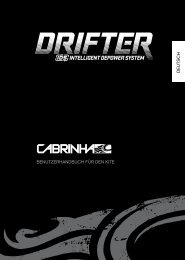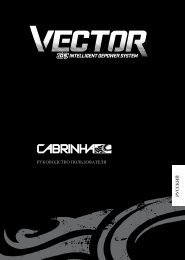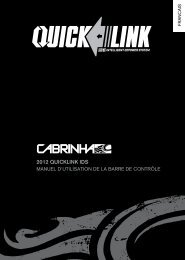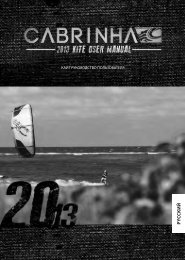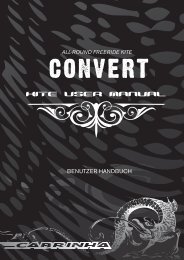2012 drifter ids⢠kite user manual manuel d'utilisation ... - Cabrinha
2012 drifter ids⢠kite user manual manuel d'utilisation ... - Cabrinha
2012 drifter ids⢠kite user manual manuel d'utilisation ... - Cabrinha
You also want an ePaper? Increase the reach of your titles
YUMPU automatically turns print PDFs into web optimized ePapers that Google loves.
<strong>2012</strong> DRIFTER IDS KITE USER MANUALMANUEL D'UTILISATION DE L'AILEBENUTZERHANDBUCH FÜR DEN KITEMANUAL DEL USUARIO DEL KITEMANUALE D’USO DEI KITEРУКОВОДСТВО ПОЛЬЗОВАТЕЛЯ
DO NOT USE THIS PRODUCT UNLESS YOU HAVE READ AND UNDERSTANDTHESE WARNINGS, CAUTIONS, AND INSTRUCTIONS WHICH ARE FOR YOURSECURITY AND PROTECTION. THIS INFORMATION MAY BE SUBJECT TOCHANGE AT ANY TIME. FOR CURRENT UPDATES, PLEASE VISIT OUR WEBSITEAT: WWW.CABRINHAKITES.COMIF YOU ARE BELOW THE AGE OF 18, YOU SHOULD HAVE YOUR PARENT ORGUARDIAN READ THESE WARNINGS, CAUTIONS AND INSTRUCTIONS ANDSHOULD NOT USE THIS PRODUCT UNLESS YOU ARE UNDER THE PROPERGUIDANCE AND SUPERVISION OF SUCH A PERSON.The use of this product exposes the <strong>user</strong> to many unavoidable and unexpected risks, injury,DANGERS and HAZARDS. The suppliers of this product are not responsible for any damage toproperty or any personal injury caused by any use, misuse, abuse or irresponsible use of thisproduct by the <strong>user</strong>.Kiteboarding is a HAZARDOUS sport. Power <strong>kite</strong>s and their lines and control equipment can beDANGEROUS to flyers and to anyone in the vicinity of their use. Kiteboarding must be taken seriouslyand we recommend that, at least in the early stages of your use, you seek the guidanceof professional instructors and experienced <strong>kite</strong>boarders. Improper and/or unreasonable use ofthis <strong>kite</strong> may result in DEATH or SERIOUS INJURY to ANY part of your body and to OTHERS. DoNOT use your <strong>kite</strong> near power lines, airports, buildings, automobiles, trees, streets, parking lots,rocks, piers, breakwaters, buoys, etc. and keep your <strong>kite</strong> fly lines away from people and ALLobstacles. Always fly in an open area and observe wind and weather conditions, particularly incircumstances where you may encounter offshore, onshore, variable or strong winds. Do NOTattempt to use your <strong>kite</strong> on water until you are confident and comfortable with the use of atrainer <strong>kite</strong> on land. Spend time to become familiar with the operation of your <strong>kite</strong> and rememberthat you are responsible for its operation and for the security of those around you. As you learnthe sport, work within your own limitations and do NOT exceed them. If you intend to use the<strong>kite</strong> on water, always use appropriate protective gears and flotation devices and do NOT attachyourself or tie yourself permanently to the <strong>kite</strong> lines. The <strong>kite</strong> is NOT intended for use as a flyingdevice nor indeed is it intended as a means of flotation....continues to next page
SNOw USE GENERAl GUIDElINES• The points listed under the Recommended Kiteboarding Practice also apply to the use of thisproduct on the snow. Please read the previous paragraphs even if you intend to use thisproduct primarily on the snow.• These <strong>kite</strong>s are intended for use on the snow as a traction device to propel a rider across wideopen snow fields in a controlled and appropriate manner.• Do NOT attempt to use this <strong>kite</strong> as a flying device. Do NOT use this <strong>kite</strong> to soar from ridges,cliffs or slopes.• Do NOT attempt to launch yourself into the air in any manner which can create excessiveimpact to the rider upon landing.• EXTREME caution must be taken when using this <strong>kite</strong> in any mountainous region, uneven terrainor glacier. Wind conditions in these areas are notoriously unstable and can change in velocityand direction without notice.• ALWAYS use appropriate protective gear. We STRONGLY recommend wearing asnowboarding specific helmet.• Do NOT tether yourself to any stationary or moving object such as a stake, snowmobile, orcar while flying this <strong>kite</strong>.• ALWAYS stay in control and be able to stop or avoid other people or objects• SNOWKITE: People downwind or down slope have right of way. It is your responsibility toavoid them• SNOWBOARD: People down slope have right of way. It is your responsibility to avoid them• You must NOT stop where you obstruct others or are not visible.• Whenever starting or merging with others look upwind/up hill and yield to others.• Always use retention devices while riding to help prevent runaway equipment. If you removehe retention device for any reason, turn snowboard upside down and push the bindings intothe snow to prevent runaways.• Observe any and all posted signs and warnings• Keep out of closed areas• SNOWBOARD: Prior to using any lift you must have the knowledge and ability to load, rideand unload safely.• Do NOT snowboard/snow<strong>kite</strong> when tired or under the influence of alcohol or drugs.• Snow terrain and snowboarding/snowkiting conditions VARY CONSTANTLY--AVOID ANYman made structures, trees, tree-wells, rocks, debris, variations in terrain or slopes, avalancheareas, crevasse, cliffs, power lines, lift lines, water hazards, changes in snow surfaces ortexture due to altitude and sun exposure, wind and weather changes, and any other conditionswhich could affect your ability to properly control your snowboard/snow<strong>kite</strong>.
CONTENTS2 Introduction3 Important Information4 Wind, Water, & Weather Conditions4 Wind Range Chart5 Know Your Ability Level / Kiteboarding Location6 Kite Care7 Beach Etiquette8 Area of Operation9 Kite Positions, Zone & PowerKITE OVERVIEW & CONTROL SYSTEM10 <strong>2012</strong> DRIFTER IDS OverviewSETUP11 Sprint Inflation System12 Inflating the Kite14 PauseHOW TO15 Repairs - Tears / Struts Bladders17 Repairs - Leading Edge Bladders19 Glossary<strong>2012</strong> DRIFTER IDS KITE USER MANUAL1
IMPORTANT INFORMATIONWIND, WATER, AND WEATHER CONDITIONS• Do NOT underestimate the power of the wind.• Be aware of unpredictable and changing weather conditions.• Avoid “offshore” or “onshore” wind conditions.• Avoid strong, gusty wind.• Be careful of wave conditions, especially when learning.• Be educated about tides and rip currents.• Be mindful of your ability level. Do NOT <strong>kite</strong>board if conditions are beyond your ability level.• Be educated about air and water temperatures and wear appropriate protection against theelements.• Do NOT use this product in thunderstorms.• Consult an anemometer and weather stations to determine wind speeds if necessary.• Do NOT use an oversized <strong>kite</strong>. Consult your Wind Range Chart for the correct recommendedsize. Use your common sense. If in doubt about what <strong>kite</strong> size to use, choose smaller ratherthan bigger.• Make certain that you are physically capable of operating the security Quick Release (QR)and IDS devices provided with this <strong>kite</strong>. This <strong>kite</strong> and control system has been designedaround a typical rider weight of 75kg(165 lbs).Riders with a weight greater than 75kg may need to use more force to operate the QR than lighterriders. Increases in wind strength may also result in greater force being required to operate the QR.Be certain to seek the advice of a professional such as your Authorized <strong>Cabrinha</strong> Dealer about theperformance of the security systems in relation to body weight.WIND RANGE CHARTThis wind range chart is only to be used as a point of reference. It is based upon a rider who isapproximately 75kg(165 lbs). Actual use may vary based on your body weight, ability level, waterconditions, board size, and riding style. When choosing a <strong>kite</strong> size, please use your personal experience,common sense, and always check what other riders are using on the water for a sizereference. Lighter riders should use a smaller <strong>kite</strong> and heavier riders may need a size larger. Becertain to seek the advice of a professional such as an instructor or Authorized <strong>Cabrinha</strong> Dealerbefore making your decision.4 <strong>2012</strong> DRIFTER IDS KITE USER MANUAL
IMPORTANT INFORMATIONKNOW YOUR ABILITY LEVEL• Do NOT attempt <strong>kite</strong>boarding without appropriateinstruction.• Do NOT <strong>kite</strong> alone.• Launch, land, and ride together with a partneror have someone on shore who can keep aneye on you.• Make sure you are in good physical conditionbefore using this product.• Practice flying a small, traction <strong>kite</strong> or a“trainer <strong>kite</strong>” before flying this <strong>kite</strong>.• The more time spent on the “trainer <strong>kite</strong>”,the faster you will learn.• Make sure you are a proficient swimmer beforeusing this product in or near the water.• Make sure the wind and water conditionsare within your ability level and that youhave made the correct equipment choices.• NEVER <strong>kite</strong>board further from shore thanyou are reasonably able to swim back.• ALWAYS save a reserve of energy; endyour <strong>kite</strong>boarding session before you areexhausted.• Make sure you’ve done your homework andthat you know the security precautions ofall aspects of the sport: rigging, Launching,landing, flying, riding, kiting among other water<strong>user</strong>s, self rescuing, etc.• Understand and practice operating your securitysystems before ever launching your<strong>kite</strong>.• Understand the technique of self-rescue beforeusing this product in or near the water.• NEVER let someone who is not familiar withinflatable <strong>kite</strong>s launch, catch, or use your<strong>kite</strong>. You will endanger them, as well asyourself and those around you.• You are responsible for the proper operationof your <strong>kite</strong>.KITEBOARDING LOCATION• Observe ALL local laws and regulations regardingthis product and the usage area.• Talk to the local riders about the weatherconditions and beach rules.• Check your area thoroughly before launchingyour <strong>kite</strong>.• Make sure you have considerable space inwhich to launch, land, and use this product.• You should have at least 100 meters ofspace from all objects on both sides anddownwind of you. Be especially aware ofyour downwind area.• Be mindful and aware of the wind directionin relation to your launch area.• Avoid areas with rocks and/or shallow orexposed reefs.• Be mindful of tide changes. As water levelschange, you may be exposed to new obstructions.• Avoid launching, landing or using this productnear power lines, telephone poles,trees, people, pets, buildings, automobiles,streets, sharp objects and airports.• Avoid crowded beaches and waterways.• Make sure your lines do not cross a walkwayor passage.• Do NOT let others walk between you andyour <strong>kite</strong>.• Be careful and mindful of other water <strong>user</strong>s,including windsurfers, boaters, jet skiers,swimmers, floating objects, etc.• Before launching, make sure you havescouted a backup landing area, in case youdo not make it back to your launch spot.<strong>2012</strong> DRIFTER IDS KITE USER MANUAL5
IMPORTANT INFORMATIONKITE CAREDue to the often extreme nature of <strong>kite</strong>boarding, a thorough approach should be takenwhen caring for your <strong>kite</strong> and all its associated rigging, as well as your protective gear.PREPARING FOR YOUR SESSION• Thoroughly check your protective equipment(helmet, etc.) to make sure it is inworking order and in good condition.• A frequent inspection of the <strong>kite</strong> and thecontrol system should be made in order toidentify punctures, tears, or abrasions inthe canopy, struts, or security systems. Itis also necessary to check the fly lines forwear and for unwanted knots, which mayreduce the strength of the fly lines. Checkbridle lines and pulleys for wear and replacewhen necessary.• Do NOT rig on asphalt, cement, gravel,or other abrasive surfaces; doing so maydamage your equipment. It is best to rigon sand or grass. Damage done to yourequipment by rigging on abrasive surfaceswill not be covered under warranty.• Do NOT rig among sharp objects that couldtear the canopy or puncture the struts andleading edge bladder.• Take care NOT to expose your flying linesto sharp objects that may wear throughthem.• While setting up, secure your <strong>kite</strong> withsand or sand bags. Do NOT secure your<strong>kite</strong> with rocks or other sharp or abrasiveobjects that may damage your <strong>kite</strong>.BETWEEN SESSIONS• NEVER leave an inflated <strong>kite</strong> unattendedon the beach for a long period of time.Winds may shift or change and the <strong>kite</strong>may become unsecured and fly off.• Do NOT leave an inflated <strong>kite</strong> (secured ornot) directly exposed to the wind for anylength of time. This allows the trailing edgeto flutter excessively. Any excessive flutteringmay quickly break down the finish propertiesof the material and reduce it’s longevity.If you must leave the <strong>kite</strong> exposed tothe wind on the beach, place sand or sandbags onto the areas of the <strong>kite</strong>, near thetrailing edge until the flutter is stabilized. Donot use rocks or other sharp objects.• Do NOT leave your <strong>kite</strong> exposed to sunlightfor long periods of time. Betweensessions, choose a shaded area to secureyour <strong>kite</strong>. When not in use, stow away.PROPER STORAGE• ALWAYS dry your <strong>kite</strong> prior to rolling orfolding. Folding or rolling a <strong>kite</strong> when wetmay affect the color clarity and longevity.• It is recommended to wash the <strong>kite</strong> componentswith fresh water and dry beforestoring.• Clear the <strong>kite</strong> of sand or other foreign objectsbefore stowing.• Once it is clean and dry, stow your <strong>kite</strong>in the supplied bag in a clean, dry, coolplace.• Do NOT place heavy objects on the bagcontaining the <strong>kite</strong>.• Do NOT leave your <strong>kite</strong> inflated in yourcar or car rack box; exposing the <strong>kite</strong> toextreme temperatures while inflated maydamage the internal bladders.• Wash your control system with fresh waterfrom time to time by placing the entire controlsystem (with lines wound onto the bar)into a bucket of fresh water and let it sit for5 minutes. Allow to dry thoroughly beforestoring in a dry location.• Once it is clean and dry, stow your controlsystem in a clean, dry cool place.6 <strong>2012</strong> DRIFTER IDS KITE USER MANUAL
BEACh ETIqUETTEHere are some basic things to consider when sharing beaches and water accesseswith other <strong>user</strong>s:SAFETY• Follow ALL of the instructions outlined in this <strong>manual</strong>, other <strong>manual</strong>s and installation guides.• Follow the instructions and rules and regulations posted at the beaches you use.• Check with local <strong>kite</strong>boarding associations and shops prior to launching in a new area. Theremay be local rules and regulations to follow which are not posted.• Utilize common sense.• Do NOT touch other people’s gear, unless instructed to do so by the owner. Picking up theirbars, <strong>kite</strong>s, etc. may disrupt a setup ritual they have.• ALWAYS secure your <strong>kite</strong> with sand or sand bags. An unmanned <strong>kite</strong> is dangerous.• NEVER leave an inflated <strong>kite</strong> unattended. Winds may shift and cause the <strong>kite</strong> to becomeunsecured and fly off.SETTING UP• Set up only the gear that you plan on using immediately. Deflate and put away your <strong>kite</strong>s whennot in use.• Set up in an area where you have plenty of space.• Set up in a manner conducive to having multiple <strong>user</strong>s in the area.• Roll up your lines when not in use.• ALWAYS keep other beach and water access <strong>user</strong>s in mind when launching, landing, and<strong>kite</strong>boarding.• Yield to other beach <strong>user</strong>s. Be courteous and cooperative.• ALWAYS be ready to lend assistance to other <strong>kite</strong>boarders. The favor may be returned soonerthan you think.<strong>2012</strong> DRIFTER IDS KITE USER MANUAL7
IMPORTANT INFORMATIONAREA OF OPERATIONThis is the 100 meters of area with no obstacles to each side and downwind of the rider. Do notlaunch your <strong>kite</strong> if you do not have this distance between yourself and other people, or obstructions.PLANNING YOUR LAUNCH• Choose an area where you have at least 100 meters of space from all obstacles to your leftand right and especially downwind of you.• Set up your equipment so that your <strong>kite</strong> is downwind of where you will be launching, but mostimportantly, so that it is at an angle off of the wind.• DO NOT SET UP YOUR KITE FOR A STRAIGHT DOWNWIND LAUNCH! The <strong>kite</strong> willlaunch with too much power and you will endanger the lives of yourself and those around youif you launch in this manner.• Basically, if the wind is at your back, and straight downwind is at a 180°, then you will want toset your <strong>kite</strong> at about a 100° off the wind, either to the left or to the right of you.• The more the <strong>kite</strong> is positioned into the wind when you launch, the less power it will have whenit goes up, and the easier your launch will be.• Your partner will stand with the <strong>kite</strong> while you will stand 30 meters away at your control bar.• Make sure you launch slowly, and launch the <strong>kite</strong> at an angle, NOT STRAIGHTDOWNWIND!POTENTIALLY HAZARDOUS:DO NOT SET YOUR KITE FOR ASTRAIGHT DOWNWIND LAUNCH.SAFERSAFERRIDER8 <strong>2012</strong> DRIFTER IDS KITE USER MANUAL
IMPORTANT INFORMATIONPOwERZONESKITE POSITIONS, ZONE & POWERIt is important to understand <strong>kite</strong>boarding’s basiczones of power before you launch a <strong>kite</strong>. Kiteboardingaccidents can happen over land when<strong>kite</strong>boarders put their <strong>kite</strong>s in what is called neutralposition. People think that the <strong>kite</strong> is stablein neutral position. However, wind fluctuates-itgusts and lulls-and in neutral position, somethingknown as lofting can occur when wind fluctuates.When a <strong>kite</strong> luffs (or receives less windin its foil), the <strong>kite</strong> will move slightly away fromthe pilot. When a gust hits, the <strong>kite</strong> receives asurge of power, and often that surge of poweris too much for a <strong>kite</strong>boarder standing with the<strong>kite</strong> high overhead. As a result, the <strong>kite</strong>boardermay be lofted (lifted) into the air. Lofting can beserious, but you may reduce the chances of loftingby understanding the power zones, and byavoiding putting your <strong>kite</strong> in the neutral positionwhile on land.Neutral Position – This is the position just abovethe pilot’s head in the sky. If the pilot levels out thebar, the <strong>kite</strong> will gravitate to the neutral position.However, it is difficult to keep the <strong>kite</strong> in this position.Although in this position the <strong>kite</strong> may feelsteady and may feel like it has the least amountof power or pull, it is also the position in whichon land the pilot is most susceptible to lofting.On the water, the neutral position can be utilizedto rest while you reel in your board, but onland, we strongly suggest you do NOT utilizethe neutral position. After launching, it is bestto make your way to the water without delay. DoNOT linger on land with the <strong>kite</strong> in neutral position–this could be potentially hazardous.Lofting – Lofting occurs when the <strong>kite</strong> is abovethe riders head in the neutral position. Instabilityin the wind can cause sudden vertical force andlift a rider off of their feet.Neutral Zone – This is the area that includesthe neutral position and the area to the left andright of the pilot. It encompasses the most upwindor windward positions in which to fly the<strong>kite</strong>. When flown here, the <strong>kite</strong> has less poweror pull than when it is in the power zone. However,use caution when the <strong>kite</strong> is in this zone,especially when on land, and especially in gustywind conditions.Power Zone – This is the area in front and tothe sides of the pilot, but excluding the neutralposition and zones. It is the area in which the<strong>kite</strong> has the most power and pull. When flownin this area, the <strong>kite</strong> can be powerful and harderto control, so avoid flying your <strong>kite</strong> in this zonewhen learning. Use extreme caution when flyingthe <strong>kite</strong> in this zone.<strong>2012</strong> DRIFTER IDS KITE USER MANUAL9
OvERvIEw<strong>2012</strong> DRIFTER IDS1. Kite Body2. Leading Edge3. Airlock High Volume Valve4. Sprint Valves5. Sprint Air Distribution Tube6. Sprint Air Clips7. Bridle8. Pulleys9. Bridle Guides10. Front line attachment point11. Rear line attachment point12. Front (center) Lines13. Steering (rear) Lines1654237 7888 89 911 10 1011*image not to scale1312 121310 <strong>2012</strong> DRIFTER IDS KITE USER MANUAL
SETUPSPRINT INFLATION SYSTEMThe SPRINT inflation system is a simple to use feature to quickly inflate your <strong>kite</strong> to an evenpressure. The SPRINT system uses a single inflation point to connect your high volume, twoway <strong>Cabrinha</strong> pump. As you pump your <strong>kite</strong> with air, all struts and your leading edge inflatequickly and simultaneously to the desired pressure. The supplied leash pump and threadedvalve connection keeps your <strong>kite</strong> under control even when pumping up directly in the wind.Once the <strong>kite</strong> is pumped you can choose to clip off the air to the struts. This way if you damagea strut while in use, the rest of the <strong>kite</strong> will maintain its pressure. At the end of the session youcan choose to deflate your <strong>kite</strong> completely by disengaging the strut clips.You can also keep your struts inflated and put your <strong>kite</strong> away rolled up so that the next sessionwill take just minutes to set up.SINGLE INFLATION VALVE FILLS THE ENTIRE KITE WITH AIRAIRLOCK INFLATION/DEFLATION VALVETHE UPPER SECTION ISTHE INFLATION CAPTHE LOWER SECTION ISTHE RELEASE VALVEFIG. 2FIG. 3FIG. 1<strong>2012</strong> DRIFTER IDS KITE USER MANUAL11
SETUPINFLATION BASICSSee the section on Kite Care before inflating your <strong>kite</strong>.• Unroll your <strong>kite</strong> with the struts facing up.• Make sure your back is to the wind and that the leading edge of the <strong>kite</strong> is closest to your body.Secure the <strong>kite</strong> with sand to keep it from flapping in the wind.• Use the supplied pump leash to connect the pump to the <strong>kite</strong>. This will free your hands topump the <strong>kite</strong>.• Open the inflation cap by turning it counter-clockwise. (FIG. 1)• Make sure that the release valve is seated firmly by turning clockwise. Do not over tighten therelease valve when the <strong>kite</strong> is not inflated. Doing so may twist and damage the bladder. Thevalve base is held in place by a Velcro disc• Attach the pump using the supplied <strong>Cabrinha</strong> adapter (or use a standard nozzle). To attach theadapter, remove the adapter from the end of the pump hose. Thread the adapter on to theupper section of the Airlock. Reattach the hose and pump the <strong>kite</strong>. (FIG. 2)• Open all of the Air Clips to allow air to flow from the LE into the struts. (FIG. 3)• When inflating, hold the pump with both hands and provide even pressure to the handle. Thiswill help maintain the life of the Pump.• Confirm that the corners of each strut under the leading edge are able to fully inflate. Lightlypush air around in the bladders until the corners are free and correctly lined up.• It is common that the LE will inflate before the struts. If a strut is not inflating, make sure thatthe air clip is open and the air tube is not pinched or damaged.FIG. APROPERLY-INFLATED KITEUNDER-INFLATED KITE• When the <strong>kite</strong> is fully inflated, remove pump hose and screwthe inflation cap back on. Lightly turn/tighten until inflation capis firmly secured.• Tighten the lower release valve.• Do not under-inflate or over-inflate the <strong>kite</strong>. Proper inflationwill make it difficult but not impossible to bend the ends of the<strong>kite</strong> in. If it is very easy to bend the wing tips in, the leadingedge is under-inflated. Your <strong>kite</strong> should be firm enough thatwhile on its back, the wing tips should extend into the air andthe <strong>kite</strong> should retain its bowed shape. (FIG. A) If the leadingedge is under-inflated, it may cause poor performance and relaunchingproblems. All <strong>kite</strong>s have been tested using 450mBpressure. NOTE: The pumps are rated to 1bar of pressure,however due to wear and tear; pumps can fail at a much lowerpressure.• It is recommended that you isolate the air in your struts. Afterthe <strong>kite</strong> is inflated, close the clips on the air distribution tubes.• Once the <strong>kite</strong> is properly inflated, turn the <strong>kite</strong> over and securewith sand. (see SETUP TIPS ON SECURING YOUR KITE)12 <strong>2012</strong> DRIFTER IDS KITE USER MANUAL
SETUPTIPS FOR SECURING YOUR KITE• Never leave an inflated <strong>kite</strong> unattended on the beachfor a long period of time. Winds may shift or changeand the <strong>kite</strong> may become unsecured and fly off.• Always secure your <strong>kite</strong> with sand, using more weightthan you think you need. An unmanned <strong>kite</strong> is dangerous.• Never secure your <strong>kite</strong> with rocks or sharp objects(including your board); they will compromise the life ofthe <strong>kite</strong>. If you do not have a sandy beach launch,consider sand bags.• Do not leave an inflated <strong>kite</strong> (secured or not), directlyexposed to the wind for any length of time. This allowsthe trailing edge to flutter excessively, which can damagethe <strong>kite</strong> or tangle the control lines. If you must leavethe <strong>kite</strong> exposed to the wind on the beach, place sufficientamounts of sand between each strut and near the trailingedge to minimize or stop the fluttering. Also, if possible,leave the <strong>kite</strong> in a shaded area.• Keep in mind other beach <strong>user</strong>s and make sure your<strong>kite</strong> and lines will not be a danger to others.• Wind your lines onto the bar when you are not kiting.This will keep the beach free of lines and will preventother beach <strong>user</strong>s from becoming tangled in yourequipment.DEFLATING THE KITEThe <strong>kite</strong> may be deflated completely or partially for yourconvenience. To deflate only the Leading Edge, you mustbe sure that all the SPRINT air clips are pinched closed,thereby isolating each individual strut. Next, unscrew therelease valve and not the inflation cap. The release valve isthe lower portion of the AIRLOCK. (FIG. A) After deflating,roll up each end of the <strong>kite</strong> starting at a wingtip and movingtowards the center. Clear the valve of any sand or debris;then seal the valve before stowing <strong>kite</strong> to prevent debrisfrom getting inside internal bladder. To deflate the entire<strong>kite</strong>, unclip the air clips at each strut. Then unscrew therelease valve. This will allow all the air to flow through theleading edge and out of the airlock.TO DEFLATEUNSCREWRELEASEVALVE.FIG. ACAUTION:When closing valve on a deflated <strong>kite</strong>, hold bladderin place to prevent twisting the bladder. Do not overtighten valve when <strong>kite</strong> is deflated. You may tightenit further when <strong>kite</strong> is partially inflated again.<strong>2012</strong> DRIFTER IDS KITE USER MANUAL13
IMPORTANT!PAUSE!FOR SETUP OF YOUR CABRINHA CONTROL SYSTEM, REFER TOYOUR SUPPLIED CONTROL SYSTEM MANUAL.IF YOU ARE UNSURE AS TO WHICH CONTROL SYSTEMS ARE COM-PATIBLE WITH THIS KITE, PLEASE REFER TO THE KITE/CONTROLSYSTEM COMPATIBILITY CHART AVAILABLE ONLINE AT WWW.CABRINHAKITES.COM.14 <strong>2012</strong> DRIFTER IDS KITE USER MANUAL
REPAIRSMAjOR TEARSFor a major tear in the <strong>kite</strong> fabric, consult your dealer for a reputable <strong>kite</strong> repair loft. To find a<strong>Cabrinha</strong> dealer in your area, please go to: http://www.cabrinha<strong>kite</strong>s.com/where_to_buy/dealer.htmlMINOR TEARSFor a minor tear in the <strong>kite</strong> fabric, you may repair the tearwith <strong>kite</strong> repair tape. Your <strong>kite</strong> has been supplied with anadhesive <strong>kite</strong> repair material.1. Clean and dry your <strong>kite</strong>.2. Lay the <strong>kite</strong> flat on a clean, dry, smooth surface.3. Cut two pieces of repair tape the same size, making surethey are each big enough to cover the entire tear.4. Carefully cover one side of the tear with a piece of therepair tape. Gently rub the tape smoothly onto the surface of the <strong>kite</strong>.5. Next, cover the opposite side of the tear with the secondpiece of repair tape, in the same manner as before.6. Make sure the tape is secure.REPAIRING STRUT BLADDERSKey Points to Remember• Before attempting to repair one of your <strong>kite</strong>bladders, make sure your <strong>kite</strong> is clean and dry.Always keep your <strong>kite</strong> pump, valves and bladdersfree of sand, water and other things that willdirty them.• Make sure the bladders are deflated.• Avoid repairing your <strong>kite</strong> on the beach or in dirty, dusty,windy, or abrasive areas. It is best to find a clean, dryspot out of the wind. A grassy spot is ideal.• You will need a set of flying lines and a bladder repair kit(supplied with <strong>kite</strong>) before you begin to repair the bladder.• Keep track of all valve parts for later use.1. First, lay the <strong>kite</strong> out flat with the struts facing up.2. Detach the Velcro closure at the end of the damagedstrut. This will open up the sleeve of the strut and willallow you access to the internal bladder. (Fig. 1)3. Next, separate the Sprint inflation tube from the LESprint valve at the affected strut by removing the tubinglock collar (LE valve) (Fig. 3).4. Slide the air clip off of the tube (Fig. 4).5. Remove the screws (2) from the base of the strut valve(Fig. 5). Keep track of the valve parts for later use.6. Tie one flying line around the valve. Cinch it down wellon the valve.7. Gently insert the valve/tube down into the strut sleeve.FIG. 1FIG. 2FIG. 3FIG. 4FIG. 5<strong>2012</strong> DRIFTER IDS KITE USER MANUAL15
REPAIRSREPAIRING STRUT BLADDERS (continued)8. Go to the base of the sleeve and gently pull the bladderFIG. 6out of the sleeve. Detach the flying line and leave it inthe sleeve. Having the flying line through the sleeve willallow you to easily replace the bladder once it isrepaired.9. Slide the air clip back onto the inflation tube. Inflate thebladder and clamp the tubing so that it maintains air. Donot over inflate the bladder.10. Submerge the bladder in water to locate the hole. Abathtub or large sink full of water is best.FIG. 711. Look for bubbles to locate the hole.12. Once you have located the leak, dry the area and markthe hole with a circle. A permanent marker works bestfor this. (FIG. 6)13. Dry and clean the rest of the bladder with a soft towel.14. Again, deflate the bladder.15. Decide whether to use the glue or a patch supplied inyour bladder repair kit.16. If the hole is on a seam, you will need to glue the area.17. If the hole is on a flat area of the bladder, remove the backing on one of the patches and pressit onto the bladder, covering the hole.18. Set the bladder aside for approximately 20 minutes to dry.19. Again, inflate the bladder and check to make sure it is now holding air.20. If you have repaired the holes in the bladder, coat the entire bladder in talcum powder to assistinsertion back into the sleeve. (OPTIONAL)21. Deflate once again.22. Tie the flying line from the end of the strut opening onto the valve.23. Lay the bladder flat at the end of the strut, so that you may now feed it back into the sleeve.24. Gently feed the valve, followed by the rest of the bladder, into the sleeve.25. From the valve opening of the sleeve, you will pull the flying line out of the sleeve, while pullingthe bladder back into place.26. Once the bladder is replaced, pull the valve back into the hole of the sleeve and remove theflying line from its base. (FIG. 7)27. Replace the Sprint base collar and tighten the screws accordingly.28. Inflate the strut partially to make sure the bladder fits into all four corners of the sleeve.29. Attach the Air Distribution tube and clip connected to the LE.16 <strong>2012</strong> DRIFTER IDS KITE USER MANUAL
REPAIRSREPAIRING LEADING EDGE BLADDERS1. First, lay the <strong>kite</strong> out with the struts facing up.2. Each end of the Leading Edge (LE) bladder is folded overand secured with a Velcro closure. You will also find a zipperaccess pocket at the center of the LE. Undo each Velcroclosure and unzip the center access pocket. This will openup the sleeve of the strut and will allow you access to thebladder. (Fig. 1,2)3. Separate the Airlock Valve Assembly from the leadingedge. Carefully lift the retainer ring from the bladder. Usingthe small pull tab on the Velcro ring, carefully peel the Airlockbase off of the inside of the LE. Keep track of the assemblyfor later use. (Fig. 3,4,5)4. Next, disassemble the Sprint valves. Remove the tubinglock collars of the strut valves (Fig. 6).5. Slide the air clips off of each tube. (Fig. 7).6. Remove the screws (2) from the base of each LE valve.(Fig. 8).7. Keep track of the valve parts for later use.8. For the next step, you will need two flying lines. Startingwith one end of the leading edge, tie one line around thewing tip end of the bladder. Cinch the line down well. Usingthe second line, follow the same procedure with the otherend of the leading edge bladder.9. Next, gently push the valves down into the strut sleeve.10. Now, access the leading edge bladder through thezippered access pocket near the leading edge valve. (Fig. 2)11. Gently pull one side of the bladder out of the sleeve at atime, leaving the flying line through both sides of the sleeve.Having the flying line through the sleeve will allow you toeasily replace the bladder once it is repaired.12. Once out of the sleeve, attach the air clips. Inflate the bladderand close all clips and the airlock valve so that it maintainsair. Do not over inflate the bladder.13. Submerge the bladder in water to locate the hole. A bathtubor large sink full of water is best. You will need to submergeone section of the bladder at a time in order to locate thehole. Look for air bubbles to locate the hole.14. Once you have located the leak, dry the area and mark thehole with a circle. A permanent marker works best for this.(Fig. 9)<strong>2012</strong> DRIFTER IDS KITE USER MANUALFIG. 1FIG. 2FIG. 3FIG. 4FIG. 5FIG. 617
REPAIRS15. Dry and clean the rest of the bladder with a soft towel.16. Again, deflate the bladder.17. Decide whether to use the glue or a patch supplied in yourbladder repair kit.18. If the hole is on a seam, you will need to glue the area.19. If the hole is on a flat area of the bladder, remove the backingon one of the patches and press it onto the bladder, coveringthe hole.20. Set the bladder aside for approximately 20 minutes to dry.21. Again, inflate the bladder and check to make sure it is nowholding air.22. Deflate once again.23. Tie each flying line to the corresponding ends of the bladder.24. Lay the bladder flat near the center access pocket and foldit, accordion style, so that you may feed each end back intothe sleeve without twisting the bladder.25. Starting with one end, feed the bladder into the accesspocket.26. Walk to one end of the leading edge and gently pull on theflying line, while holding the end of the sleeve. Slowly feedthe bladder back into this side of the sleeve. (Fig. 10)27. Next, follow the same instructions with the other side of thebladder, until the valves are near the holes and the bladderis fully inserted.28. Tuck the ends of the bladder into the corresponding tips.29. Once the bladder is replaced, pull the valves back into theholes of the sleeve. (Fig. 11)30. Next, place the Sprint valves back into position. (Fig. 12)31. Making sure not to catch the internal bladder in the zipper,close the center LE zipper pocket. Next, fold over wingtipaccess pockets and secure the Velcro strips.32. Re-attach the Airlock Valve Assembly.33. Partially inflate the Leading Edge to make sure the bladderfits into all four corners of the sleeve.34. Reassemble the Sprint valves and connect the airdistribution tubes to each strut.FIG. 7FIG. 8FIG. 9FIG. 10FIG. 11FIG. 1218 <strong>2012</strong> DRIFTER IDS KITE USER MANUAL
FREQUENTLY USED KITEBOARDING& WIND TERMINOLOGYAAIR DISTRIBUTION TUBESTubes that connect the LE bladder to the strut bladders.AIR-LOCK - a 2 part valve that allows a single point for inflationand deflation of the <strong>kite</strong>.AIR CLIPSClips that prevent air transfer between the LE and thestruts.BBAR (unit) – A unit of pressure• 1 bar = 14 PSI• 1 mbar = 0.015 PSIPSI – A unit of pressure. Pounds per square inch• 1 PSI = 68.9mbarBEAUFORT SCALEA system for estimating wind strength based on the effectswind has on the physical environment (e.g. the behavior ofwaves, smoke, etc.). Instruments are not used to determinewind strengths in this point scale (O = calm to 12 = hurricane).BODY DRAGGINGThis is an instructional tactic / step in which the rider fliesthe <strong>kite</strong> while in the water, but without the board. The riderwill launch, then walk to the water, and basically drag in thewater while practicing flying, re-launching and self-rescuetechniques.BLADDERThe inner inflatable tube found within the leading edge andthe struts of the <strong>kite</strong>. (Imagine a bike-it has both a tire on theoutside and an inner tube which holds air).BRIDLESThe lines that hang from the wing tips and leading edge ofthe <strong>kite</strong>. The flying lines will be attached from the control barto these bridle lines in order to connect control bar to <strong>kite</strong>.Tow Points – The attachment points for the bridle.BYPASS LEASH SYSTEMAn optional security leash feature that is recommended forfirst time <strong>user</strong>s and <strong>kite</strong>boarding schools, and for riders who<strong>kite</strong>board without being hooked into the harness loop.CCENTERLINE ADJUSTMENT STRAP (CAS)Used to depower the <strong>kite</strong> by changing the relationship betweenthe front and back line lengths. It is also used to position thebar closer to the rider.CONTROL BARThe steering device the rider uses to steer the <strong>kite</strong>.DDE-POWER LINESThe two center flying lines that attach to the leading edgebridles on the <strong>kite</strong>-one to the left wing tip, the other to theright wing tip. These lines assist in de-powering the <strong>kite</strong>.DOWNWINDThe direction in which the wind is traveling.FFLYING LINESA term used to describe all four of the lines included with your<strong>kite</strong> package. These lines connect the bridle lines on the <strong>kite</strong>to the leader lines on the control bar and are typically 20-30meters in length.GGUSTY WINDWind is inconsistent and varies considerably from one windstrength to another.GYBINGThe motion in which the rider changes the direction of theboard he/she is riding. The rider switches from a starboardtack to a port tack or vice versa.HHARNESSA piece of equipment used to temporarily attach the rider tothe control bar harness line. This enables the rider to saveenergy by utilizing their body weight and all of their musclesto hang on to the <strong>kite</strong>. Most common are the waist harness(attaches around the torso) and the seat harness (attaches tothe waist and around the legs).IIDS (INTELLIGENT DEPOWER SYSTEM)IDS is a simplified bridle and control system that seamlesslyprovides 2 stages of depower.INFLATABLE KITEA <strong>kite</strong> with inflatable tubes designed to float the <strong>kite</strong> and tofacilitate water re-launchability.K<strong>2012</strong> DRIFTER IDS KITE USER MANUALGlOSSARyKITEBOARDINGThe term used to describe the sport of power kiting on wateror snow.19
GlOSSARyKITESURFINGAnother term used to describe the sport of power kiting onwater.KNOTSA measure of speed based on nautical miles.1 knot = 1 nautical mile per hour.1 knot = 1.15 miles per hour.1 knot = 1.85 kilometers per hour.LLANDINGThe action which places the <strong>kite</strong> on the water or on land.LAUNCHINGThe motion in which the rider steers the <strong>kite</strong> from their partner’shands into the sky.LEADER LINESThe lines that attach directly to the control bar. You will attachthese lines to the flying lines in order to connect themto your bar.LEADING EDGE (LE)The front inflated tube of your <strong>kite</strong>.LEEWARDThe downwind side of the <strong>kite</strong>boarder.LOFTINGLofting occurs when the <strong>kite</strong> is above the riders head in theneutral position. Instability in the wind can cause sudden verticalforce and lift a rider off of their feet.LUFFA term used to describe what happens to the <strong>kite</strong> in a lull.A term also used to describe the complete de-powering ofa <strong>kite</strong>.LULLA term used to describe wind when it lessens in strength, forany amount of time.MMPHMiles Per Hour. A measure of speed.1 mph = 1.6 kilometers per hour.NNEUTRAL POSITIONThis is the position just above the rider’s head in the sky. Ifthe rider levels out the bar, the <strong>kite</strong> will gravitate to the neutralposition. However, it is difficult and dangerous to keep the<strong>kite</strong> in this position. Although in this position the <strong>kite</strong> may feelsteady and may feel like it has the least amount of power orpull, it is also the position in which on land the rider is mostsusceptible to lofting. On the water, the neutral position canbe utilized to rest while you reel in your board, but on land, westrongly suggest you do not utilize the neutral position. Afterlaunching, it is best to make your way to the water withoutdelay. Do NOT linger on land with the <strong>kite</strong> in neutral position.It is VERY dangerous.NEUTRAL ZONEThis is the area that includes the neutral position and the areato the left and right of the rider. It encompasses the mostupwind or windward positions in which to fly the <strong>kite</strong>. Whenflown here, the <strong>kite</strong> has less power or pull than when it is inthe power zone. However, use caution when the <strong>kite</strong> is inthis zone, especially when on land, and especially in gustywind conditions.OOFFSHOREWind is blowing from the shore directly or to a great extentout to the water. Do not operate your <strong>kite</strong> in or near water inthis wind direction.ONSHOREWind is blowing directly or to a great extent directly from thewater toward the land. Do not operate your <strong>kite</strong> in or nearwater in this wind direction.OVER-POWEREDA situation in which the rider has a <strong>kite</strong> too powerful for his/her ability level, weight, strength, and/or wind conditions.PPLANINGThe point in time in which the rider gets the board skimmingon the water.POWER ZONEThis is the area in front and to the sides of the rider, but excludingthe neutral position and zones. It is the area in whichthe <strong>kite</strong> has the most power and pull. When flown in this area,the <strong>kite</strong> can be powerful and dangerous, so avoid flying your<strong>kite</strong> in this zone when learning. Use extreme caution whenflying the <strong>kite</strong> in this zone.PUMP – Device used to inflate the <strong>kite</strong>. QQQRS-QUICK RELEASE SECURITY SYSTEMA quick release point on the control system which, when activated,detaches the control system from the harness loop.Also referred to as the Main QR.QR2A secondary quick release on the Quicklink Body which whenactivated separates the landing line from the IDS Tower. Thusseparating the <strong>kite</strong> from the rider.QUICKLINKQuicklink refers to the molded harness loop body andQR2 pin. This combined system gives the <strong>user</strong> a quick20 <strong>2012</strong> DRIFTER IDS KITE USER MANUAL
GlOSSARyand effective way to reconnect the IDS connector to the IDStower after full deployment. The Quicklink body also offersthe <strong>user</strong> the chance to interchange harness line lengths.RREACHA direction of travel relative to the wind direction. Generally90-160 degrees off the wind.RECOILRecoil is a convenience item, which allows riders a spot torest the bar while unspinning it from rotational tricks. It alsoserves as a unit to keep tension on the bungee adjusterswhile keeping them at arms reach.RE-LAUNCHINGThe motion in which the rider steers the <strong>kite</strong> off of the waterand back into the sky.SSIDE OFFSHOREWind is blowing from either the left or the right and from theshore out to the water. This is a combination of offshore andsideshore wind. Do not operate your <strong>kite</strong> in or near water inthis wind direction.TTRAINER KITEA <strong>kite</strong> that may be used on land to simulate the motions usedin <strong>kite</strong>boarding. It is an excellent instructional and learningtool. Despite its small size, this <strong>kite</strong> still has power, so bealert.UUNDER-POWEREDA situation in which the rider has a <strong>kite</strong> not powerful enoughfor his/her weight, strength, and/or wind conditions.UPWINDThe direction from which the wind is blowing.WWATER STARTINGThe motion of the rider in which he/she goes from sitting orlying in the water to standing on the board.WINDWARDThe upwind side of the <strong>kite</strong>boarder.SIDESHOREWind is blowing from the left or from the right, parallel to theshore. Ideal wind direction for <strong>kite</strong>boarding.SIDE ONSHOREWind is blowing from either the left or the right and from thewater toward the land. This is a combination of onshore andsideshore wind. Utilize caution when operating your <strong>kite</strong> in ornear water in this wind direction.SPRINTSingle Point Rapid Inflation Technology.STAGE 2 DEPOWERStage 2 Depower is a built in function of IDS which allows therider to self land a <strong>kite</strong> on the water or land.STEERING LINESThe two outside flying lines that attach to the trailing edgebridles on the <strong>kite</strong>-one to the left wing tip and the other tothe right wing tip.STRUTSThe outer fabric tubes found on your <strong>kite</strong>. They house theinner inflatable bladders, which are filled with air to give structureto the <strong>kite</strong>.<strong>2012</strong> DRIFTER IDS KITE USER MANUAL21




